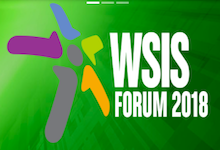Building a framework for digital innovation in agriculture
22 Mar 2018 11:00h - 13:00h
Event report
[Read more session reports from the WSIS Forum 2018]
The moderator Mr James Azevedo Görgen, senior IT officer, Digital Innovation and Development at the Food Agriculture Organization (FAO), introduced the speakers and explained the aim of this facilitation meeting. He stressed the 13 years of successful collaboration between the FAO and the International Telecommunication Union (ITU). Görgen said that it is necessary to develop a strategic framework for sustainable digital innovation to support the collaboration of UN agencies, partners, and national governments in implementing ICTs and digital innovation programmes and increase e-agriculture initiatives and capacity development. The aim of such a framework is to achieve (a) accelerated upscaling of critical services; (b) reduced deployment costs addressing urban and rural realities; (c) enhanced public awareness and engagement; (d) improved innovation, connectivity, productivity, and efficiency; and (e) faster upgrading in the quality of services and employment opportunities.
Mr Yushi Torigoe, chief of the Administration and Operations Coordination Department at the ITU, elaborated on the subject of co-operation between the ITU and the FAO and mentioned some successful examples like the E-Agriculture Strategy Guide and the #HackAgainstHunger hackaton. He then talked about the ITU’s work in the field of e-agriculture on an international as well as a national level. Torigoe suggested that the continuing diversification of agricultural challenges will create a need for a strategic framework for the sustainable development of e-agriculture.
The next speaker, Ms Laura Bordin, associate creative director at Frog Design, briefed the audience on the social impact activities of her company that focuses on digital and product design. Bordin said that the need for more food will require precision farming and the use of artificial intelligence. The experience of her company showed that the most important element of any service is a human-centred approach. Owners and creators of any service should care about people and their problems and spend some time with them in the field. It is important to learn, design, and test with the community. The life-cycle of a service has been shifting from a linear method to a recursive one. The proper method now is to hide complexity and build services around the community.
Mr Cliff Schmidt, executive director at AMPLIO (formerly Literacy bridge), presented a practical case of a human-centred design service. Literacy bridge developed the Talking Book project that contributes to the sharing of knowledge through audio technology. The talking book is an audio computer designed for the learning needs of an illiterate population. It provides helpful audio information to farmers on how to improve their farming techniques. The information is provided by local and national agricultural experts in the local language and dialect. The device is robust, mobile, and can collect audio feedback from farmers. The results show that the farmers increased their harvest by 48% thanks to this audio guidance. Schimdt expressed a belief that services should not be delivered to people who do not understand technology and do not own the necessary devices. This increases the digital gap even more.
Mr Hani Eskandar, ICT applications coordinator at the ITU, presented a case proposal for a common digital agriculture platform. The current problem of IT solutions and platforms is that they are closed boxes in silos. The value creation is linear and one-way. Eskandar gave an example of the application architecture for the agriculture sector from Andrah Pradesh State in India.
The discussion with the audience tackled problems of collaboration and knowledge sharing among organisations active in the field of e-agriculture. Another point discussed the high cost of precision farming. The average farmer in India owns 2–3 acres of land. The solution could be an association of farmers sharing the technology and the burden of cost. A considerate amount of time was dedicated to the discussion on how to operate and set up a common digital agriculture platform.
In the last round, the speakers were asked to give a take-away from the workshop. Suggestions included:
-
Front-end innovation should focus on user experience while back-end innovation should focus on the interoperability of systems and the breaking of silos.
-
Adopting a user-centred approach is the key
-
Partnerships among governments, organisations, and business are important.
-
Knowledge must be accompanied by resources. (It is good to know how to farm better but it is useless without fertilizers, seeds, etc.)
-
Big data must be beneficial rather than simply a summary of data that does not provide any help in making the right decisions.
By Radek Bejdak
Related topics
Related event

